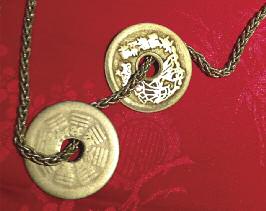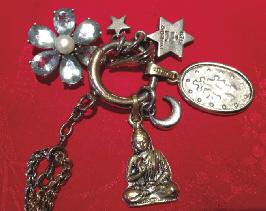Every trinket tells a story.
You might say I live a charmed life. Yes, life is good for the most part, but that’s not what I’m talking about. Over the years, I have been the recipient—and sometime purchaser—of dozens of charms. In contrast to T.S. Eliot’s J. Alfred Prufrock, who measured the banality of his life in coffee spoons, I can trace much positive meaning in my life from each of the charms I’ve acquired. It’s weird that these inanimate objects, the charms, have come to represent my life, my family, my friends and my spiritual beliefs.
The hodge-podge doesn’t look bad. When I jingle past the jewelry cases at Bergdorf Goodman, more often than not, I am stopped by a shop girl asking, “Where did you get those necklaces?” as though a designer had created the look. The collection has grown to five separate necklaces and, to be succinct, I explain that it’s a compilation of good luck charms I’ve been given over the years.
 The saga of this collection started decades ago, in my early 20s, when I was working overseas at the Asian Wall Street Journal and studying Mandarin with a Chinese sage who, locals believed, could tell the past, present and future. People from all over Asia sought him out to help them with decisions big and small—where to bury an ancestor, which boyfriend to favor, whether a potential business partner was trustworthy. When I decided to return to the states, a fellow language student presented me with a Chinese coin. Not an old round one with a square hole in the center, like old Chinese money. No, it was a token for good luck, with the eight trigrams of the I Ching on it. The sage had suggested she give it to me to enhance my luck. I never considered myself superstitious—no rabbit’s paws, evil eyes or four-leaf clovers for me—yet, I put the token on a red string and wore it on my wrist. Over time, the sage gave me another Chinese token with Taoist writing on it, so it joined the other coin. Fine, two coins…
The saga of this collection started decades ago, in my early 20s, when I was working overseas at the Asian Wall Street Journal and studying Mandarin with a Chinese sage who, locals believed, could tell the past, present and future. People from all over Asia sought him out to help them with decisions big and small—where to bury an ancestor, which boyfriend to favor, whether a potential business partner was trustworthy. When I decided to return to the states, a fellow language student presented me with a Chinese coin. Not an old round one with a square hole in the center, like old Chinese money. No, it was a token for good luck, with the eight trigrams of the I Ching on it. The sage had suggested she give it to me to enhance my luck. I never considered myself superstitious—no rabbit’s paws, evil eyes or four-leaf clovers for me—yet, I put the token on a red string and wore it on my wrist. Over time, the sage gave me another Chinese token with Taoist writing on it, so it joined the other coin. Fine, two coins…
Now that I’m thinking about it, I do have to lay blame for the next set of charms again on the Chinese sage. This time he was in New York enjoying a Cantonese feast with some Chinese beauties and they were discussing what Chinese animal complemented their birth years. This complementary animal can be used for anything from finding a mate to merely bestowing luck. The sage explained there are two ways to discern fortuitous animals. First there was the best animal match for their birth animal. I’m born in the year of the Dragon so those born in the year of the Rooster are best partners. Then there is a more mystical match system called the Three Harmonies, which identifies the animals that are four years before and four years after your birth year. So the Rat and the Monkey create a sort of sacred triangle with the Dragon. You follow me? As the Chinese beauties were discussing whether to get porcelain, jade or stuffed animals to decorate their homes, I thought No tchotchkes for me, hey I like gold, and what could be more auspicious than to constantly wear the symbols of harmony?
Finding those animals was no easy feat, as charms were not in fashion in the early 1980s. Eventually, I located a gold rat, monkey and rooster; my mother bought me a gold chain necklace and had a jeweler attach the charms and, voila, I’m a lucky girl! (Fast forward, I happened to marry a “rat,” our son is a “monkey,” and our daughter was due in the year of the rooster, but was born three months early in the year of the monkey…all further blessing my life.) Meanwhile, I bought a gold chain to hang the original Chinese good luck tokens.
The next additions—a heart and moneybag, which I attached to an old watch chain—came from a co-partner in a New York restaurant. She wanted to make sure we all were blessed with good luck. For the record, the restaurant thrived until the manager got greedy and we decided to close rather than deal with his crooked ways. Still, we made a profit.
My neck was becoming encircled with charms of whimsy, superstition and serendipity. The next ones were spiritual. When I married my rat in 1985, the Chinese sage arrived at the chapel in New York and presented me with a huge red macramé necklace with a Tibetan Buddha hanging at the end. It really didn’t go with my grandmother’s 1912 Edwardian couturier gown, but how could I refuse? He put it over my head, as if he were knighting me, and I tried to discretely tuck it under the décolletage. All was good: the wedding went off with out a hitch, eventually the macramé disintegrated, and I’m still married to the same rat. Now the Buddha charm hangs from the chain necklace with the auspicious animals, balanced by a jade Buddha from Hong Kong.
The next spiritual addition was a “miraculous” medal. Sixteen years ago, my husband developed an aneurysm in an artery that wraps around his brain stem. Many of our friends sought to provide help and comfort. Besides having a leading neurosurgeon operate, it was an ecumenical effort with monks, nuns, swamis, rabbis and priests of all faiths praying. After successful surgery, I was talking to a friend about the power of faith, no matter what the religion, and he mentioned he had Mother Theresa’s nuns praying for my husband. He gave me a tin medallion of the Virgin Mary, which had actually been blessed by Mother Theresa—which I added to another chain, as I admired Mother Theresa’s good works. The fact that, when the medallion’s attaching loop broke I had the medallion encased in gold, speaks to the deep admiration I have of Mother Theresa’s selfless good deeds.
I cannot attest to any miracles per se, but the medal has helped open doors to amazing friendships and instant goodwill from the few who recognized its spiritual significance: The niece of the French nun who, after dreaming the Virgin Mary instructed her, designed the medal; and an art historian with whom I have spent many hours in discussions of existence and spirituality. Being with them is a celebration of life and our higher selves. Were it not for the medal, we would have never discovered our commonality. I have since introduced them to each other.
I also wear charms on my wrist. These change according to the Chinese New Years. 2014 is the year of the Horse, so to ensure an auspicious year, I will wear a complementary Ram charm and harmonious Dog and Tiger charms.
To round out the spirituality—as I am ecumenical and believe all religions offer a deep wisdom—I added a Star of David, a crescent moon and star, my children gave me a St. Christopher’s medal, and my son gave me a Lama-blessed Buddha charm he purchased while hiking in Ladakh, India. I also have a blue topaz flower charm designed by a friend (I love gardening) and a tin Eiffel tower (I love Paris) assembled in a mish-mash from a long watch chain I bought as a home for the new additions.
My charms are markers of my life’s journey, as well as expressions of my hope for peace and belief in human commonality.

Beijing after 30 years for EDGE. Some charms, Sarah admits, have proved to be problematic—like the double-swastika charms that the Chinese sage gave to her. The swastika for over a millennium has been a potent Buddhist symbol, which unfortunately was adopted—backwards—by the Nazis. “Should I arrive unconscious at a hospital,” she says, “it might test any doctor’s Hippocratic oath to save my life.”
Editor’s Note: Sarah Rossbach speaks Mandarin, has traveled extensively in Asia and published several books on Feng Shui. In 2013, she wrote about a return trip to




